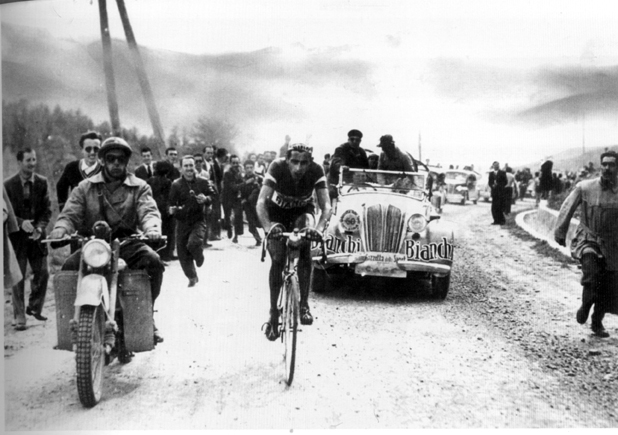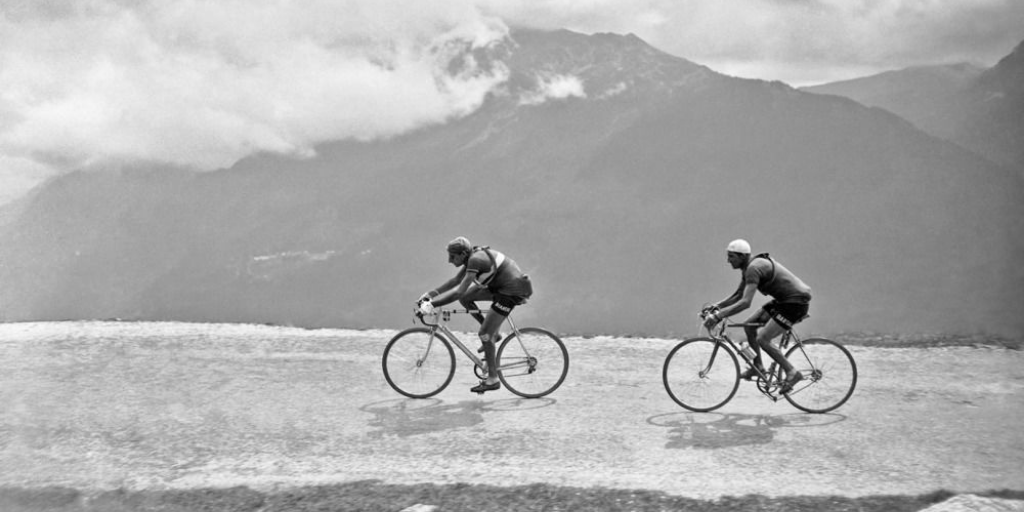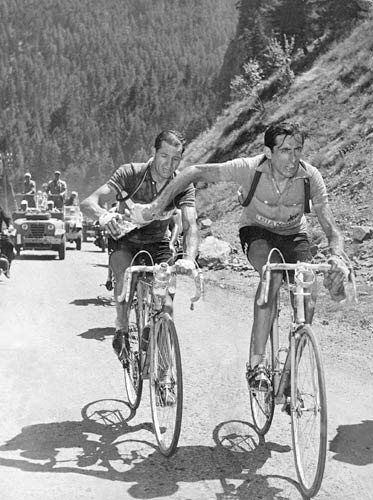The rivalry between Fausto Coppi and Gino Bartali was one of the most iconic in cycling and Italian sports history, marked by athletic brilliance, ideological contrast, and deep personal drama. Beginning with Coppi’s breakthrough win in the 1940 Giro d’Italia under Bartali’s mentorship, the two developed a fierce competition that mirrored Italy’s postwar tensions—Bartali the devout, conservative hero, and Coppi the modern, rebellious icon. Their battles at the Giro and Tour de France produced legendary moments, including Coppi’s solo ride from Cuneo to Pinerolo, Bartali’s 1948 Tour victory that helped calm political unrest, and the famous water bottle exchange in 1952. Despite divisions that once split the nation and even sidelined Italy from the 1950 World Championships, the two eventually reconciled in retirement. Their rivalry transcended sport, becoming a powerful symbol of Italy’s past, identity, and enduring love of cycling.
Here are nine iconic moments of their rivalry:
1. 1940 Giro d’Italia – The beginning of a legend
Fausto Coppi was just 20 years old, a relatively unknown helper on Gino Bartali's team, Legnano, when he shocked the cycling world by winning the Giro d’Italia. Initially, Coppi was meant to be a gregario (domestique) for Bartali, the team leader and already a Giro and Tour winner. However, as Bartali struggled with form, Coppi's strength on the climbs and time trials became impossible to ignore. In a symbolic twist, Bartali reportedly told team management to let Coppi ride for himself after realizing the young rider had better legs. Coppi went on to take the overall win, becoming the youngest Giro champion at that time. This passing of the torch was unspoken but undeniable—and marked the first friction point in what would become a legendary rivalry.
2. The war years – a rivalry frozen, lives diverged
The rivalry was paused as WWII erupted, but both men lived very different wartime experiences that would influence their post-war personas. Bartali remained in Italy, using his cycling fame to operate as a secret courier for the Catholic Church and Italian resistance. He smuggled forged documents hidden in his bicycle frame to help Jews escape Nazi persecution—something he didn’t publicize for decades. Coppi, on the other hand, was drafted into the military, captured in North Africa, and spent time as a prisoner of war in Tunisia. While both suffered personal and professional setbacks, Bartali returned a symbol of moral righteousness and tradition, while Coppi emerged disillusioned, progressive, and increasingly rebellious—socially and stylistically. These differing experiences laid the groundwork for a rivalry that went beyond sport, reflecting Italy's ideological divides.
3. 1946 Giro d’Italia – postwar Italy and a bitter return
The first Giro after the war was electrified by the resumption of the Coppi–Bartali rivalry. Italy, recovering from fascism and war, looked to sport for inspiration—and got drama instead. The 1946 Giro was marred by infighting, sabotage accusations, and stage disputes between the two icons. In one critical stage, Coppi gained time after a Bartali mechanical, leading to accusations of unsportsmanlike conduct. Bartali, furious and feeling betrayed, refused to appear on the podium when Coppi was crowned champion. It wasn’t just personal; their fans were equally divided—southern Catholics and older Italians backed Bartali, while northern workers and the youth rallied behind Coppi. The tension was so thick, fights broke out among spectators during stages, and Italian newspapers fanned the flames.
4. Tour de France 1948 – Bartali’s nNational redemption
Bartali was considered past his prime by 1948, yet he delivered one of the most dramatic victories in Tour de France history. After a slow start, he dominated the Alps, winning three consecutive mountain stages and taking the yellow jersey. Remarkably, this happened shortly after an assassination attempt on Italian politician Palmiro Togliatti. Prime Minister Alcide De Gasperi reportedly called Bartali personally, urging him to bring home a win to calm the unrest in the streets. Bartali delivered, and his victory was seen as a moment of national healing. More than a cycling triumph, it was a symbol of unity in a country on the brink of civil strife. While Coppi sat out that Tour, he watched as Bartali reasserted his status as the lion of Italian cycling, albeit temporarily.
5. 1949 Giro d’Italia – The Cuneo to Pinerolo epic ride
This stage has entered cycling mythology. On a cold, rainy day in the Alps, Fausto Coppi launched a solo attack from Cuneo to Pinerolo, crossing five major mountain passes—Maddalena, Vars, Izoard, Monginevro, and Sestriere.

He dropped every rival, including Bartali, and rode 192 kilometers alone, gaining over 11 minutes. Radio commentator Mario Ferretti’s legendary line—“Un uomo solo è al comando…”—became iconic. Bartali, struggling behind, could only watch history being made. This ride wasn’t just a physical triumph; it was Coppi’s declaration of dominance, using style, strategy, and sheer power to etch his name permanently into cycling history. Many consider it the greatest single stage performance ever.
6. Tour de France 1949 – The year of the double

Only weeks after his dominance in the Giro, Coppi achieved the unthinkable: winning the Tour de France in the same season, becoming the first cyclist ever to do so. He crushed the field in the mountains and time trials, putting on a masterclass in versatility. Bartali tried to challenge him but could not match Coppi’s power and consistency. The French fans, who had long admired Bartali’s fighting spirit, now turned their admiration to Coppi’s effortless grace. The dual victories changed cycling history, setting a precedent that very few have matched. For Bartali, it was a bitter pill—he had helped bring Coppi into the limelight and was now being completely overshadowed. Their rivalry had reached its most unequal point.
7. 1950 World Championships –divided they fell
The rivalry had become so intense and politically charged that the Italian cycling federation refused to send a national team to the 1950 World Championships, fearing that Coppi and Bartali’s factions would not cooperate. Team unity was impossible, and both men were accused of putting ego before country. Italy’s absence from a major international event highlighted how their rivalry had grown larger than the sport itself—a national drama playing out on two wheels. Fans and media took sides, and the federation’s decision was both a scandal and a tragedy. It was a missed opportunity for Italy and a low point for the two riders, who had let personal animosities overshadow their responsibilities to their country.
8. Tour de France 1952 – The water bottle moment
This stage in the Alps produced a photograph that has come to symbolize their entire relationship. During a brutal mountain climb, Coppi and Bartali—by now both aging icons—shared a water bottle. Or did they?

The image shows Coppi holding out a bottle to Bartali, but some say it was the other way around. Debates over this moment have lasted decades, but the truth is secondary to the symbolism: even in rivalry, there was mutual respect. That year, Coppi again dominated, winning the Tour with ease. But the bottle photo humanized both men and became an emblem of sportsmanship, even amid years of bitterness.
9. 1953 World Championships – Coppi’s final glory
By 1953, Bartali was in decline, while Coppi still had one final masterpiece left. At the World Championships in Lugano, Coppi attacked late in the race and soloed to victory, winning the rainbow jersey that had eluded him. It was a crowning achievement—a global title that placed him among the all-time greats. Bartali, absent from the podium and no longer a threat, had to watch as Coppi basked in universal adulation. It was their last major divergence as elite competitors. Though Bartali remained active for a few more years, the era of their duel was over. Coppi had won more, but both had etched their names into legend through contrast, not similarity